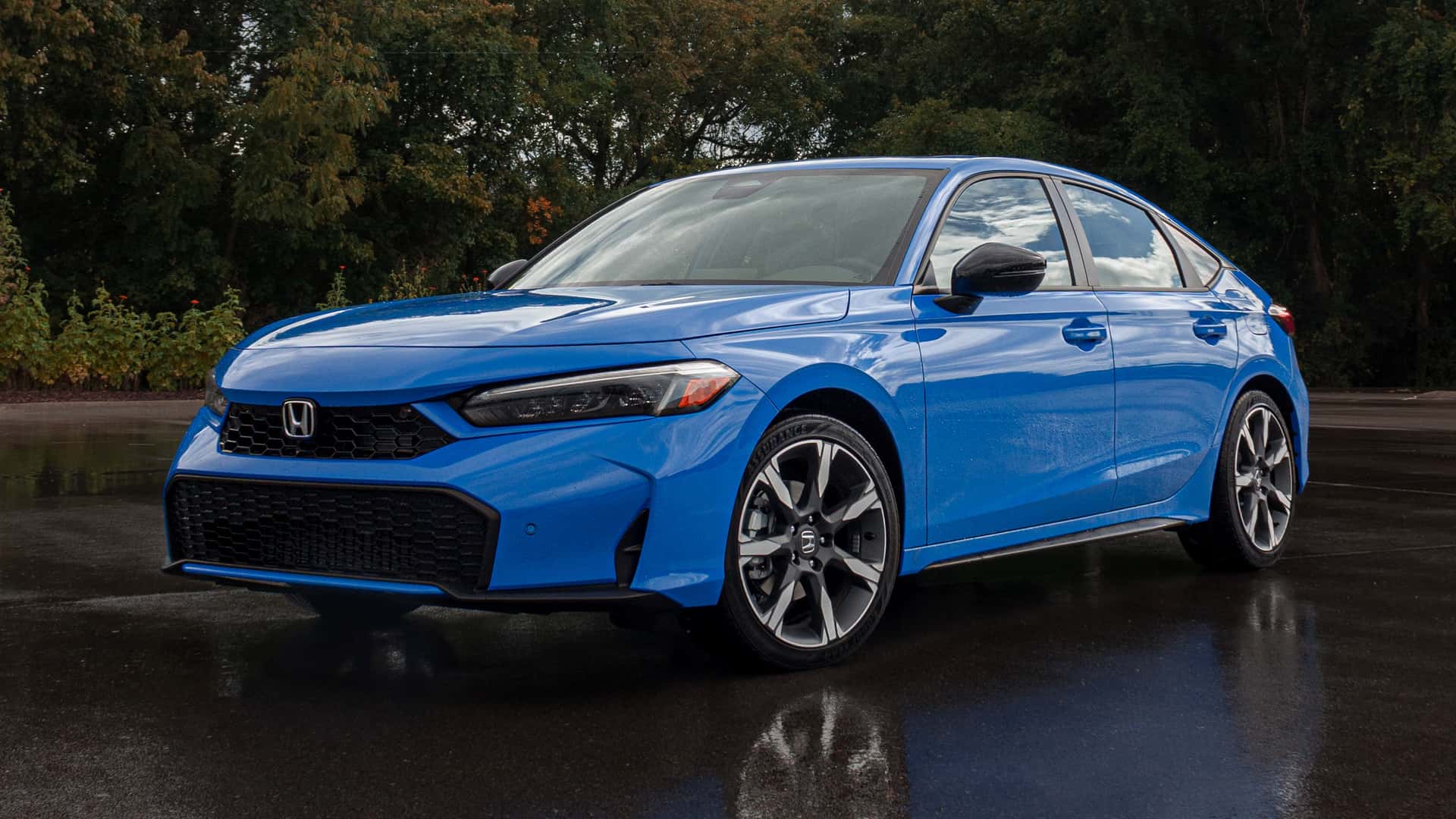
WHAT COULD MAKE THE HONDA CIVIC BETTER? A HATCH AND A HYBRID
The 2025 Honda Civic hatchback hybrid is the future of commuter cars.
Hybrid cars deserve a better reputation. They’re no longer the niche, eco-conscious choice—they’re our modern reality, and they’re great. The 2025 Honda Civic hybrid hatchback proves that.
| Quick Specs | 2025 Honda Civic Hatchback Hybrid |
| Engine | 2.0-Liter Four-Cylinder Hybrid |
| Output | 200 Horsepower / 232 Pound-Feet |
| Fuel Economy | 50 City / 47 Highway / 49 Combined MPG |
| Drive Type | Front-Wheel Drive |
| Base Price | $31,045 / $34,500 (est.) |
By trim options alone, the 2025 Civic hatchback is mostly hybrid. Only the base $28,545 Sport trim is fully gas-powered, and it has a 2.0-liter, four-cylinder engine that makes 150 horsepower and 133 pound-feet of torque.
Above that, Honda offers two more options: the $31,045 Sport Hybrid and $34,045 Sport Touring Hybrid, which are now the top trims on any Civic (sedan or hatchback). They both come with a 2.0-liter engine and a two-motor hybrid, and I drove the Sport Touring Hybrid for this story. (All prices include a $1,095 destination fee.)
With the hybrid system, the Civic hatch jumps to 200 horsepower and 232 pound-feet of torque. That’s a big deal in the context of the car, since Honda’s halo Civic is the Type R hot hatch. The Type R makes 315 horsepower and comes exclusively with a six-speed manual transmission, and Honda’s advertising the hybrids as the "most powerful non-Type R Civic[s] ever." It’s true: They’re more powerful than the Si performance trim, which makes 200 horsepower and 192 pound-feet of torque.
That power is obvious when driving the car. The new Civic hybrids aren’t fast—it’s a Civic, not a sports car—but they are quick, and "quick" is all most people need. Modern hybrids also have tons of benefits over traditional gas-powered commuter cars, but two of my favorites are the convenience and the smoothness.
Pros: Convenient Electric Power, Smooth Driving
First, the convenience: The Civic hybrid doesn’t need to be plugged in. The battery charges while the car drives, giving buyers the benefit of electricity without the need to plug the car in. There’s a lot less electricity available on a hybrid like the Civic compared to modern hybrids that do plug in, since they offer electric-only range that you can commute on. But there’s enough electricity to get you 49 mpg combined in the Civic, all without plugging it in.
The next major benefit is smoothness. While an average-powered, gas-only commuter car—like a Civic—will softly grunt up to speed, the mixture of internal-combustion engine and electric power on a hybrid allows that process to be a smooth, quiet glide. There’s an elasticity to electrified acceleration, like rotating a rubber band with your index fingers, and it makes the drive feel more elegant.
The Civic hybrid is quiet and docile at low speeds, while the accelerator and brake pedals are quick to respond to your feet. They also have a nice weight to them, like the steering wheel does. The suspension smooths out bumps and dips in the road, and Honda’s lane-keep assist lets you say goodbye to one of the most tedious parts of driving: those tiny steering inputs needed to keep the car in its lane on the highway.
On the outside, the Civic hatch is well-styled but tame. It’s one of those cars that’ll still look fine in 15 years, because there’s nothing daring about it now. The Civic’s styling is like a pair of black combat boots: They may not be the most visually thrilling choice, but they meet a basic need that’ll be there for years to come.
Cons: Conservative Styling
If you need more excitement but still want a Civic hatch hybrid, it has the option for Honda’s Boost Blue paint (pictured in this story) that’s popularly seen on the Type R. I adore Boost Blue, and I wish every 2025 Civic had it—the sedan and Si performance trims do not.
Inside, the hybrid hatch takes the same conservative approach. I had a car with a light-gray and black interior, and nothing jumped out at me except the nice herringbone pattern around the cup holders. Automakers usually put piano black in this area in modern cars, and not doing that is a huge plus: Piano black is a grease and dirt magnet, while the herringbone isn’t. The herringbone is also prettier.
The hybrid Civic is indicative of our new reality: electrified commuter cars. It’s a good new reality, too. The technology is more mainstream, more capable, and more affordable today than it’s ever been, and that’s evidenced by the Civic itself: the first hybrid Civic in America arrived in 2003 with 40 mpg combined and a base price of $19,550, which would be about $34,000 today.
The 2025 hybrid Civic gets 49 mpg combined and starts at $29,845 (sedan) or $31,045 (hatchback). That’s not a bad deal.
We’re in a golden era of hybrid commuter cars, and the Honda Civic hybrid hatchback is one of them. That may not sound like the most exciting thing in the world, but if you’re in the market for a new car, I assure you: It is.
Competitors
More Honda Civic Reviews
| 2025 Honda Civic Hatchback Sport Touring Hybrid | |
| Engine | 2.0-Liter Four-Cylinder Hybrid |
| Output | 200 Horsepower / 232 Pound-Feet |
| Efficiency | 50 City / 47 Highway / 49 Combined MPG |
| Seating Capacity | 5 |
| Cargo Volume | 24.5 Cubic Feet |
| Drive Type | Front-Wheel Drive |
| Base Price | $31,045 |
| Trim Base Price | $34,045 |
| As-Tested Price | $34,500 (est.) |
| On Sale | Now |